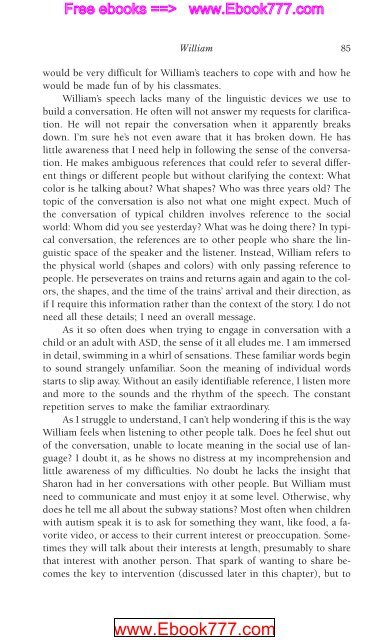978-1572305441
autism
autism
Create successful ePaper yourself
Turn your PDF publications into a flip-book with our unique Google optimized e-Paper software.
Free ebooks ==> www.Ebook777.com<br />
www.Ebook777.com<br />
William 85<br />
would be very difficult for William’s teachers to cope with and how he<br />
would be made fun of by his classmates.<br />
William’s speech lacks many of the linguistic devices we use to<br />
build a conversation. He often will not answer my requests for clarification.<br />
He will not repair the conversation when it apparently breaks<br />
down. I’m sure he’s not even aware that it has broken down. He has<br />
little awareness that I need help in following the sense of the conversation.<br />
He makes ambiguous references that could refer to several different<br />
things or different people but without clarifying the context: What<br />
color is he talking about? What shapes? Who was three years old? The<br />
topic of the conversation is also not what one might expect. Much of<br />
the conversation of typical children involves reference to the social<br />
world: Whom did you see yesterday? What was he doing there? In typical<br />
conversation, the references are to other people who share the linguistic<br />
space of the speaker and the listener. Instead, William refers to<br />
the physical world (shapes and colors) with only passing reference to<br />
people. He perseverates on trains and returns again and again to the colors,<br />
the shapes, and the time of the trains’ arrival and their direction, as<br />
if I require this information rather than the context of the story. I do not<br />
need all these details; I need an overall message.<br />
As it so often does when trying to engage in conversation with a<br />
child or an adult with ASD, the sense of it all eludes me. I am immersed<br />
in detail, swimming in a whirl of sensations. These familiar words begin<br />
to sound strangely unfamiliar. Soon the meaning of individual words<br />
starts to slip away. Without an easily identifiable reference, I listen more<br />
and more to the sounds and the rhythm of the speech. The constant<br />
repetition serves to make the familiar extraordinary.<br />
As I struggle to understand, I can’t help wondering if this is the way<br />
William feels when listening to other people talk. Does he feel shut out<br />
of the conversation, unable to locate meaning in the social use of language?<br />
I doubt it, as he shows no distress at my incomprehension and<br />
little awareness of my difficulties. No doubt he lacks the insight that<br />
Sharon had in her conversations with other people. But William must<br />
need to communicate and must enjoy it at some level. Otherwise, why<br />
does he tell me all about the subway stations? Most often when children<br />
with autism speak it is to ask for something they want, like food, a favorite<br />
video, or access to their current interest or preoccupation. Sometimes<br />
they will talk about their interests at length, presumably to share<br />
that interest with another person. That spark of wanting to share becomes<br />
the key to intervention (discussed later in this chapter), but to



